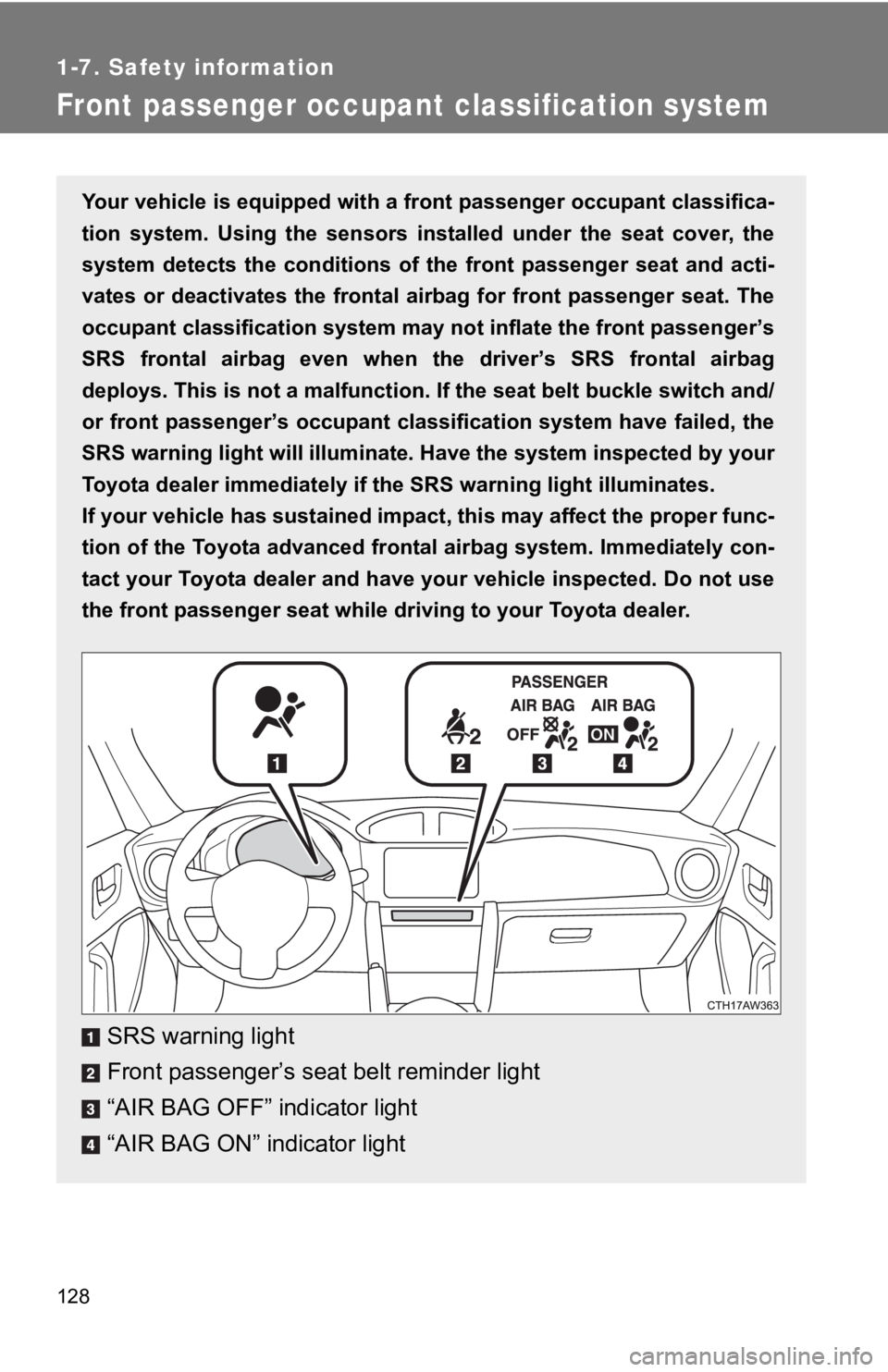airbag off TOYOTA 86 2020 Owners Manual
[x] Cancel search | Manufacturer: TOYOTA, Model Year: 2020, Model line: 86, Model: TOYOTA 86 2020Pages: 532, PDF Size: 8 MB
Page 94 of 532

94 1-7. Safety information
SRS airbag system componentsFront sub sensor (right-hand
side)
SRS warning light
Frontal airbag module
(driver's side) (two-stage)
Front passenger’s frontal air-
bag ON and OFF indicator
(center of instrument panel)
Frontal airbag module (front
passenger’s side) (two-
stage)
Front passenger’s occupant
detection control module
Door impact sensor (right-
hand side)
Curtain shield airbag mod-
ule (right-hand side)
Airbag wiring
Side airbag module (front
passenger’s side) Side airbag sensor (center
pillar right-hand side)
Curtain shield airbag sensor
(rear wheel house right-hand
side)
Seat belt pretensioner (front
passenger’s side)
Satellite safing sensor
(under the center of the rear
seats)
Front passenger’s occupant
classification system sensor
Seat belt buckle switch (front
passenger’s side)
Seat belt pretensioner
(driver’s side)
Curtain shield airbag sensor
(rear wheel house left-hand
side)
Page 97 of 532

97
1-7. Safety information
1
Before driving
■
Driver’s SRS frontal airbag
The driver’s SRS frontal airbag uses a dual stage inflator. The inflator oper-
ates in different ways depending on the severity of impact.
Have the system inspected by your Toyota dealer immediately if the SRS
warning light illuminates.
NOTE
The driver’s SRS side airbag and SRS curtain shield airbag are not con-
trolled by the Toyota advanced frontal airbag system.
■ Front passenger’s SRS frontal airbag
The front passenger’s SRS frontal airbag uses a dual stage inflator. The
inflator operates in different ways depending on the severity of impact.
The occupant classification system sensor is installed under th e seat uphol-
stery and monitors the physique and posture of the front passen ger. Using
this information, the occupant classification system determines whether the
front passenger’s SRS frontal airbag should be deployed or not.
The occupant classification system may not inflate the front passenger’s
SRS frontal airbag even when the driver’s SRS frontal airbag de ploys. This
is normal. In this case, although the front passenger’s SRS fro ntal airbag
does not operate, the front passenger’s seat belt pretensioner operates with
the driver’s seat belt pretensioner. For details about the seat belt preten-
sioner, refer to “Seat belt pretensioners”. ( P. 61)
Observe the following precautions. Failure to do so may prevent the Toyota
advanced frontal airbag system from functioning correctly or ca use the sys-
tem to fail.
● Do not apply any strong impact to the front passenger’s seat.
● Do not spill liquid on the front passenger’s seat. If liquid is spilled, wipe it
off immediately.
● Do not remove or disassemble the front passenger’s seat.
● Do not install any accessory (such as an audio amplifier) other than a
genuine Toyota accessory under the front passenger’s seat.
● Do not place anything (shoes, umbrella, etc.) under the front p assenger’s
seat.
● Do not place a magnet near the seat belt buckle.
Page 98 of 532

98 1-7. Safety information
If the seat belt buckle switch and/or front passenger’s occupant classification
system have failed, the SRS warning light will illuminate. Have the system
inspected by your Toyota dealer immediately if the SRS warning light illumi-
nates.
If your vehicle has sustained impact, this may affect the proper function of
the Toyota advanced frontal airbag system. Have your vehicle in spected at
your Toyota dealer. Do not use the front passenger’s seat while driving the
vehicle to your Toyota dealer.
NOTE
The front passenger’s SRS side airbag and SRS curtain shield ai rbag are
not controlled by the Toyota advanced frontal airbag system.
■ Passenger’s frontal airba g ON and OFF indicators
P. 128
■ Occupant classification system
The occupant classification system sensor is installed under th e seat uphol-
stery and monitors the physique and posture of the front passen ger. Using
this information, the occupant classification system determines whether the
front passenger’s SRS frontal airbag should be deployed or not.
If the front passenger’s seat cushion is wet, this may adversel y affect the
ability of the system to determine deployment. If the seat cush ion is wet, the
front passenger should stop sitting on the front passenger’s se at. Wipe off
liquid from the seat immediately, let the seat dry naturally an d then check the
SRS warning light as follows.
● If the SRS warning light illuminates, keep the seat dry until t he warning
light turns off. If the SRS warning light stays on even when the seat has
dried, do not allow anyone to sit on the front passenger’s seat and have
the system checked by your Toyota dealer.
● If the SRS warning light does not illuminate, check that the fr ont passen-
ger’s frontal airbag ON and OFF indicators work properly. If th e indicators
do not work properly, do not allow anyone to sit on the front p assenger’s
seat and have the system checked by your Toyota dealer.
Page 99 of 532

99
1-7. Safety information
1
Before driving
Also, if luggage or electronic devices are placed on the front
passenger’s
seat, this may adversely affect the ability of the system to determine deploy-
ment. This may prevent the front passenger’s frontal airbag ON and OFF
indicators from working properly. Check that the indicators wor k properly.
When the OFF indicator turns off and the ON indicator illuminat es, the front
passenger’s frontal airbag may deploy during a collision. Remov e luggage
and electronic devices from the front passenger’s seat.
NOTE
This device complies with Part 18 of the FCC Rules. This device may cause
interference. If this device causes interference, consult the n earest Toyota
dealer. Also, for maintenance of the system, consult the neares t Toyota
dealer.
■ Conditions in which front passen ger’s SRS frontal airbag is not acti-
vated
The front passenger’s SRS frontal airbag will not be activated when any of
the following conditions are met regarding the front passenger’s seat:
● The seat is empty.
● The seat is equipped with an appropriate child restraint system and an
infant is restrained in it.
● The occupant changed their posture after the occupant load is j udged.
● The front passenger’s occupant classification system is malfunctioning.
WARNING
When the front passenger’s seat is occupied by an infant in an appropriate
child restraint system, observe the following precautions. Fail ure to do so may
interfere with the proper operation of the occupant classification system, acti-
vating the front passenger’s SRS frontal airbag even though tha t seat is occu-
pied by the infant in the child restraint system.
● Do not place any article (including electronic devices) on the seat other than
the infant in the child restraint system.
● Do not place more than one infant in the child restraint system.
Page 100 of 532

100 1-7. Safety information
■If the front passenger’s frontal a irbag ON indicator illuminates and the
OFF indicator turns off even when an infant or a small child is in a child
restraint system (incl uding booster seat)
Turn the engine switch to the “LOCK” position (vehicles without a smart key
system), or turn the “ENGINE START STOP” switch off (vehicles w ith a
smart key system) if the front passenger’s frontal airbag ON in dicator illumi-
nates and the OFF indicator turns off even when an infant or a small child is
in a child restraint system (including booster seat). Remove th e child
restraint system from the seat. By referring to the child restraint manufac-
turer’s recommendations as well as the child restraint system installation
procedures in “Child restraint systems” ( P. 137), correctly install the child
restraint system. Turn the engine switch to the “ON” position ( vehicles with-
out a smart key system), or turn the “ENGINE START STOP” switch to IGNI-
TION ON mode (vehicles with a smart key system) and make sure that the
front passenger’s frontal airbag ON indicator turns off and the OFF indicator
illuminates.
If still the ON indicator remains illuminated while the OFF ind icator turns off,
take the following actions.
● Ensure that no article is placed on the seat other than the chi ld restraint
system and the child occupant.
● Ensure that the backward-forward position and seatback of front passen-
ger’s seat are locked into place securely by moving the seat back and
forth.
If the ON indicator still remains illuminated while the OFF indicator turns off
after taking relevant corrective actions described above, reloc ate the child
restraint system to the rear seat and immediately contact your Toyota dealer
for an inspection.
NOTE
When a child who has outgrown a child restraint system or a sma ll adult is
seated in the front passenger’s seat, the Toyota advanced front al airbag sys-
tem may or may not activate the front passenger’s SRS frontal a irbag
depending on the occupant’s seating posture. The child should a lways wear
the seat belt when sitting in the seat irrespective of whether the airbag is
deactivated or activated. If the front passenger’s SRS frontal airbag is acti-
vated (the ON indicator remains illuminated while the OFF indic ator turns
off), take the following actions.
Page 101 of 532

101
1-7. Safety information
1
Before driving
●
Ensure that no article is placed on the seat other than the occupant.
If the ON indicator still remains illuminated while the OFF indicator turns off
despite the fact that the actions noted above have been taken, seat the
child/small adult in the rear seat and immediately contact your Toyota dealer
for an inspection. Even if the system has passed the dealer ins pection, it is
recommended that on subsequent trips the child/small adult alwa ys take the
rear seat.
Children who have outgrown a child restraint system should alwa ys wear the
seat belt irrespective of whether the airbag is deactivated or activated.
■ Conditions in which fr ont passenger’s SRS frontal airbag is activated
The front passenger’s SRS frontal airbag will be activated for deployment
upon impact when any of the following conditions are met regard ing the front
passenger’s seat.
● When the seat is occupied by an adult.
● When a certain item(s) (e.g. jug of water) is placed on the seat.
Page 102 of 532

102 1-7. Safety information
■If the passenger’s frontal airbag OFF indicator illuminates and the ON
indicator turns off even when the front passenger’s seat is occ upied by
an adult
This can be caused by the adult incorrectly sitting in the fron t passenger’s
seat. Turn the engine switch to the “LOCK” position (vehicles w ithout a smart
key system), or turn the “ENGINE START STOP” switch off (vehicl es with a
smart key system). Ask the front passenger to set the seatback to the
upright position, sit up straight in the center of the seat cushion, correctly
fasten the seat belt, position his/her legs out forward, and ad just the seat to
the rearmost position. Turn the engine switch to the “ON” posit ion (vehicles
without a smart key system), or turn the “ENGINE START STOP” sw itch to
IGNITION ON mode (vehicles with a smart key system). If the OFF indicator
remains illuminated while the ON indicator remains off, take th e following
actions.
● Vehicles without a smart key system:
Turn the engine switch to the “LOCK” position.
Vehicles with a smart key system:
Turn the “ENGINE START STOP” switch off.
● Make sure that the front passenger does not use a blanket, seat cushion,
seat cover, seat heater or massager, etc.
● If wearing excessive layers of clothing, the front passenger should
remove any unnecessary items before sitting in the front passenger’s
seat, or should sit in a rear seat.
● Next, turn the engine switch to the “ON” position and wait 6 se conds to
allow the system to complete self-checking. Following the syste m check,
both indicators turn off for 2 seconds. Now, the ON indicator should illu-
minate while the OFF indicator remains off.
If the OFF indicator still remains illuminated while the ON ind icator remains
off, ask the occupant to move to the rear seat and immediately contact your
Toyota dealer for an inspection.
Page 124 of 532

124 1-7. Safety information
WARNING
■SRS airbag precautions
●Do not touch any of the component parts immediately after the S RS air-
bags have deployed (inflated) as they may be hot.
● If breathing becomes difficult after the SRS airbag has deploye d, open a
door or window to allow fresh air in, or leave the vehicle if i t is safe to do
so. Wash off any residue as soon as possible to prevent skin ir ritation.
● If the areas where the SRS airbags are stored, such as the stee ring wheel
pad and front and rear pillar garnishes, are damaged or cracked, have
them replaced by your Toyota dealer.
■ Modification and disposal of SRS airbag system components
Do not dispose of your vehicle or perform any of the following modifications
without consulting your Toyota dealer.
The SRS airbags may malfunction or deploy (inflate) accidentall y, causing
death or serious injury.
● Installation, removal, disassem bly and repair of the SRS airbag s.
● Repairs, modifications, removal or replacement of the steering wheel,
instrument panel, dashboard, seats or seat upholstery, front, side and rear
pillars or roof side rails.
● Repairs or modifications of the front fender, front bumper, or side of the
occupant compartment.
● Installation of a grille guard (bull bars, kangaroo bar, etc.), snow plows,
winches.
● Modifications to the vehicle's suspension system.
● Installation of electronic devices such as mobile two-way radios and CD
players.
● Modifications to your vehicle for a person with a physical disa bility.
Page 126 of 532

126 1-7. Safety information
●Side airbag module (fro nt passenger’s side)
● Curtain shield airbag sensor (re ar wheel house right-hand side)
● Curtain shield airbag sensor (re ar wheel house left-hand side)
● Curtain shield airbag module (right-hand side)
● Curtain shield airbag module (left-hand side)
● Satellite safing sensor (under the center of the rear seats)
● Seat belt pretensi oner (driver’s side)
● Seat belt pretensioner (front passenger’s side)
● Seat belt buckle switch (front passenger’s side)
● Front passenger’s occupant cla ssification system sensor
● Front passenger’s occupan t detection control module
● Front passenger’s frontal air bag ON and OFF indicator
● All related wiring
Page 128 of 532

128
1-7. Safety information
Front passenger occupant classification system
Your vehicle is equipped with a front passenger occupant classifica-
tion system. Using the sensors installed under the seat cover, the
system detects the conditions of the front passenger seat and acti-
vates or deactivates the frontal airbag for front passenger seat. The
occupant classification system m ay not inflate the front passenger’s
SRS frontal airbag even when the driver’s SRS frontal airbag
deploys. This is not a malfuncti on. If the seat belt buckle switch and/
or front passenger’s occupant classification system have failed, the
SRS warning light will illuminate. Have the system inspected by your
Toyota dealer immediately if the SRS warning light illuminates.
If your vehicle has sustained im pact, this may affect the proper func-
tion of the Toyota advanced frontal airbag system. Immediately con-
tact your Toyota dealer and have your vehicle inspected. Do not use
the front passenger seat while driving to your Toyota dealer.
SRS warning light
Front passenger’s seat belt reminder light
“AIR BAG OFF” indicator light
“AIR BAG ON” indicator light